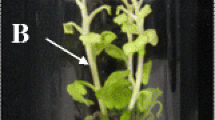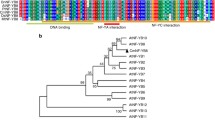Abstract
Chrysanthemum (Dendranthema grandiflorum Kitam.) is one of the qualitative short-day flowering plants. Therefore, the flowering of chrysanthemum can usually be controlled by photoperiod. However, it was noted that ‘Piato’ plants infected by the chrysanthemum stunt viroid (CSVd) flowered autonomously even under long-day conditions. In this study, CSVd-free and CSVd-infected plants were prepared by culturing different-sized dissected shoot apical meristems (SAMs) of ‘Piato’. Using these CSVd-free and CSVd-infected plants, we clarified the relationship between CSVd infection and the autonomous flowering of ‘Piato’. Under natural short-day conditions, the flowering of plants regenerated from SAMs containing leaf primordia (LPs) was 1 month earlier than plants regenerated from LP-free SAMs. CSVd was detected from these early flowering plants by reverse transcription–polymerase chain reaction. On the other hand, CSVd was not detected in plants regenerated from LP-free SAMs. CSVd-infected and CSVd-free plants were grown under long-day conditions simulated by night-break lighting at 22:00 p.m. to 2:00 a.m. All CSVd-infected plants flowered autonomously even under long-day conditions; on the other hand, CSVd-free chrysanthemum plants maintained their vegetative growth. When the CSVd-free plants were inoculated with CSVd by grafting them to CSVd-infected rootstocks, they flowered autonomously even under night-break lighting. In this study, the results suggest that CSVd may control the qualitative development process, flowering, i.e. CSVd can induce the autonomous flowering of chrysanthemum.





Similar content being viewed by others
Abbreviations
- CSVd :
-
Chrysanthemum stunt viroid
- SAM :
-
Shoot apical meristem
- LP :
-
Leaf primordium
References
Brierley P, Smith FF (1949) Chrysanthemum stunt. Phytopathology 39:501
Cathey HM, Borthwick HA (1957) Photoreversibility of floral initiation in chrysanthemum. Bot Gaz 119:71–76
Cathey HM, Borthwick HA (1961) Cyclic lighting for controlling flowering of chrysanthemum. Proc Am Soc Hort Sci 78:545–552
Cathey HM, Borthwick HA (1964) Significance of dark reversion of phytochrome in flowering of Chrysanthemum moriforium. Bot Gaz 125:232–236
Dimock AW (1947) Chrysanthemum stunt. N Y State Flower Grow Bull 26:2
Flores R, Randles JW, Bar-Josef M, Diener TO (2000) Subviral agents: viroids. In: van Regenmortel MHV, Pringle CR, Wickner RB (eds) Virus taxonomy. Seventh report of the International Committee on Taxonomy of Viruses. Academic Press, San Diego, pp 1009–1024
Gora A, Candress T, Zagorski W (1996) Use of intermolecular chimeras to map molecular determinants of symptom severity of potato spindle tuber viroid (PSTVd). Arch Virol 141:2045–2055
Hammond RW (1992) Analysis of the virulence modulating region of potato spindle tuber viroid (PSTVd) by site-directed mutagenesis. Virology 187:654–662
Hollings M, Stone OM (1973) Attempts to eliminate chrysanthemum stunt from chrysanthemum by meristem-tip culture after heat-treatment. Ann Appl Biol 73:333–348
Horst RK, Cohen D (1980) Amantadine supplemented tissue culture medium: a method for obtaining chrysanthemum free of chrysanthemum stunt viroid. Acta Hort 110:315–319
Horst RK, Langhans P (1977) Effect of chrysanthemum stunt, chlorotic mottle, aspermy and mosaic on flowering and rooting of chrysanthemums. Phytopathology 67:9–14
Hosokawa M, Otake A, Sugawara Y, Hayashi T, Yazawa S (2004a) Rescue of shoot apical meristems of chrysanthemum by culturing on root tips. Plant Cell Rep 22:443–448
Hosokawa M, Otake A, Ohishi K, Ueda E, Hayashi T, Yazawa S (2004b) Elimination of chrysanthemum stunt viroid from an infected chrysanthemum cultivar by shoot regeneration from a leaf primordium-free shoot apical meristem dome attached to a root tip. Plant Cell Rep 22:859–863
Itaya A, Matsuda Y, Gonzales RA, Nelson RS, Ding B (2002) Potato spindle tuber viroid strains of different pathogenicity induces and suppresses expression of common and unique genes in infected tomato. Mol Plant Microbe Interact 15:990–999
Knop W (1865) Quantitative untersuchungen uber die ernahrungsprozesse der pflanzen. Landwirtsch Vers Stn 7:93–107
Kryczynski S (1983) Transmission of viroids and viruses by tissue implantation and transport across the callus barrier. Phytopathol Z 106:63–57
Largton (1977) The response of early-flowering chrysanthemums to daylength. Sci Hort 1:277–289
Morton A, Barbara DJ, Adams AN (1993) The distribution of hop latent viroid within plants of Humulus luplus and attempts to obtain viroid-free plants. Ann Appl Biol 123:47–53
Murashige T, Skoog F (1962) A revised medium for rapid growth and bioassay with tobacco tissue culture. Physiol Plant 15:473–497
Okada M (1957) Classification of chrysanthemum varieties in view of their environmental responses to flowering. J Hort Assoc Jpn 26:59–72
Owens RA, Thompson SM, Steger G (1991) Effect of random mutagenesis upon potato spindle tuber viroid replication and symptom expression. Virology 185:18–31
Owens RA, Chen W, Hu Y, Hsu YH (1995) Suppression of potato spindle tuber viroid replication and symptom expression by mutations which stabilize the pathogenicity domain. Virology 208:554–564
Owens RA, Steger G, Hu Y, Fels A, Hammond RW, Riesner D (1996) RNA structural features responsible for potato spindle tuber viroid pathogenicity. Virology 222:144–158
Paduch-Cichal E, Kryczynski S (1987) A low temperature therapy and meristem-tip culture for eliminating four viroids from infected plants. J Phytopathol 118:341–346
Qi Y, Ding B (2003) Inhibition of cell growth and shoot development by a specific nucleotide sequence in a noncoding viroid RNA. Plant Cell 15:1360–1374
Ringe F, Nitsch JP (1968) Conditions leading to flower formation on excised Begonia fragments cultured in vitro. Plant Cell Physiol 9:639–652
Sano T, Candresse T, Hammond RW, Diener TO, Owens RA (1992) Identification of multiple structural domains regulating viroid pathogenicity. Proc Natl Acad Sci USA 89:10104–10108
Schnolzer M, Hass B, Ramm K, Hoffman H, Sanger HL (1985) Correlation between structure and pathogenicity of potato spindle tuber viroid (PSTVd). EMBO J 4:2181–2190
Schrader O, Baumstark T, Riesner D (2003) A mini-RNA containing the tetraloop, wobble-pair and loop E motifs of the central conserved region of potato spindle tuber viroid is processed into a minicircle. Nucleic Acids Res 31:988–998
Singh RP, Boucher A, Seabrook JEA (1988) Detection of the mild strains of potato spindle tuber viroid from single true potato seed by return electrophoresis. Phytopathology 78:663–667
Visvader JA, Symons RH (1985) Eleven new sequence variants of citrus exocortis viroid and correlation of sequence with pathogenicity. Nucleic Acids Res 13:2907–2920
Wassenegger M, Spieker RL, Thalmeir S, Gast F-U, Riedel L, Sanger HL (1996) A single nucleotide substitution converts potato spindle tuber viroid (PSTVd) from a noninfectious to an infectious RNA for Nicotiana tabacum. Virology 226:191–197
Yamashita Y, Hirata Y, Hataya T, Sano T, Fukui H, Shikata E (1997) Studies on production of viroid-free nursery plant in spray type chrysanthemum. 2. Basic studies on production methods of CSVd-free chrysanthemum. J Jpn Soc Hort Sci [Suppl 1] 66:526–527
Zhu Y, Green L, Woo YM, Owens R, Ding B (2001) Cellular basis of potato spindle tuber viroid systemic movement. Virology 279:66–77
Author information
Authors and Affiliations
Corresponding author
Rights and permissions
About this article
Cite this article
Hosokawa, M., Ueda, E., Ohishi, K. et al. Chrysanthemum stunt viroid disturbs the photoperiodic response for flowering of chrysanthemum plants. Planta 220, 64–70 (2004). https://doi.org/10.1007/s00425-004-1318-2
Received:
Accepted:
Published:
Issue Date:
DOI: https://doi.org/10.1007/s00425-004-1318-2




